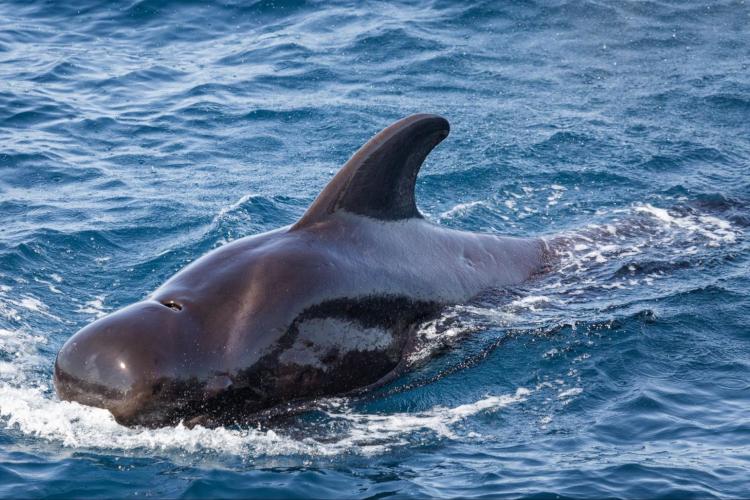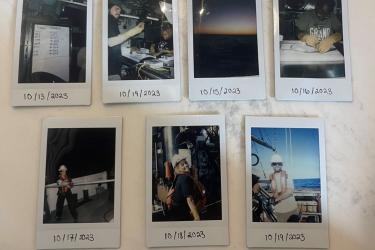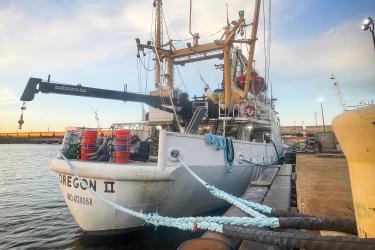The final leg of NOAA’s Southeast 2023 Vessel Survey for Abundance and Distribution of Marine Mammals and Seabirds in the Gulf of Mexico ended with great success! Data collected during this survey will be used to update what we know about where marine mammals and seabirds occur and the number of individuals in the Gulf. Ultimately, these data will help guide future management and restoration efforts.
“During this leg, the marine mammal and bird teams were able to hear, observe, identify, and count a vast number of species. I was very proud of what we accomplished together on this long trip,” Tony Martinez, the field chief scientist, stated.
What We Saw
The marine mammal team ended the final leg with exciting sightings of the endangered Rice’s whale! In total there were two sightings of Rice’s whales and a third sighting of baleen whales that were most likely Rice’s whales. It can be challenging to identify animals to species level in the field since some look very similar when observed from a safe viewing distance.
Learn more about our sighting of the endangered Rice’s whale
The first two Rice’s whale sightings were in the northeastern Gulf of Mexico, which is believed to be the core habitat for the species. Scientists have collected acoustic and genetic data that show Rice’s whales regularly occur in the western Gulf as well. More data is needed to understand the distribution and abundance of the population. The sighting of probable Rice’s whales occurred in the western Gulf of Mexico—adding valuable information to what we know so far regarding Rice’s whale distribution.
The probable Rice’s whale sighting in the western region was lucky. The observer teams had already stopped working for the day, but two scientists remained on the flying bridge, or the top deck, to watch the sunset and relax. One of the scientists was looking out at the right time when two baleen whales surfaced. Other scientists were alerted immediately, and joined the effort to photograph and identify the whales. Unfortunately, because of the fading daylight, we were unable to collect the photographs or biopsy that are needed to definitively confirm the species identification. However, we can determine they were most likely Rice’s whales since they are the only resident baleen whales in the Gulf of Mexico. Sightings of other baleen whales in the Gulf, while possible, are very rare.
Another high point for the marine mammal observer team was getting a close look at two groups of short-finned pilot whales. The groups were memorable because of their large size and how many calves they contained.
At one point, a group of striped dolphins rode the bow of the vessel. This is an unusual behavior for striped dolphins, so scientists were excited for the chance to watch them.
Another important component of this excursion was identifying and counting the various seabirds that visit or reside across the Gulf of Mexico. There were also many highlights from this effort, which can be explored in our previous blog post.
What We Heard
The acoustics team detected many marine mammal vocalizations on this leg using a towed hydrophone array to listen to sound underwater. Marine mammals produce sounds in order to navigate, eat, and communicate with each other. These recordings teach us more about the density, distribution, and behavior of marine mammals in the Gulf. One of the most exciting highlights from the acoustic work was a crisp and clear recording of a whale belonging to the genus Kogia (a pygmy or dwarf sperm whale).
Jonny Reid, an acoustician explained, “The Kogia detection was distinct and a great example of a Kogia vocalization. This is the best acoustic encounter I’ve had with this species.”
Pygmy and dwarf sperm whale sounds are ultrasonic (90–140 kilohertz). People are unable to hear these sounds as the maximum frequency of human hearing is around 12–19 kilohertz, depending on age. The spectrogram below shows a visual representation of the recorded sound.
The acoustics team was also able to make clear recordings of the short-finned pilot whale groups. The recordings showcased the harmonics in their whistles. These could be heard more clearly as the groups came closer to the vessel.
A third acoustic highlight was the detection of many sperm whales. Sperm whales produce distinct clicks that are used for navigation and communication. Reid explained, “We had 46 sperm whale detections throughout the final leg. One encounter that stood out was an individual that was located 15 kilometers away from the ship. Sperm whales produce unique, regular echolocation clicks only when diving, making them easy to identify using acoustics.”
Learn more about listening to the sounds of the Gulf of Mexico
What We Learned
This 2-month long journey allowed us to collect a tremendous amount of information about several species of marine mammals and many seabirds in the Gulf of Mexico. These data can help us make better, informed decisions on the long term conservation and management of these populations. They can help us limit the risks to marine mammal and seabird populations from activities such as aquaculture and wind energy development. Continued collection of this information can also help improve restoration planning to make sure that projects are designed to provide maximum benefits to species that may have been impacted by the Deepwater Horizon oil spill.
Read the rest of our blog series to learn more about what we saw and heard on this trip!
Meet the Blogger
Ellie Hartman
Ellie Hartman was born and raised in Breckenridge, Colorado. She was a communications intern, research assistant, and marine mammal observer for NOAA's Southeast Science Center. She graduated from Barry University with a Master's of Business Administration and graduated from University of Miami with a Master's of Professional Science in Marine Conservation. Meet Ellie










